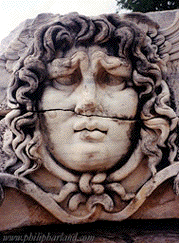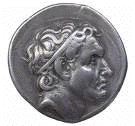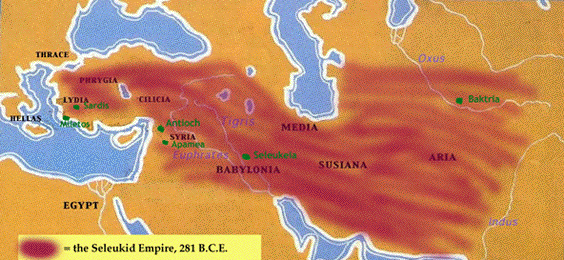Emperor Ashoka
February 10, 2008
Ashoka (also sometimes transliterated as "Asoka"), the grandson of Chandragupta – the founder of the Mauryan dynasty – and the son of Bindusara, came to the throne circa 268 B.C. and died approximately 233 B.C. He is chiefly known from his series of rock and pillar inscriptions, which are found scattered in various parts of India and provide important information about his reign and policies. After eight years of rule, he waged a fierce war against the kingdom of Kalinga (Orissa of today) and was so horrified at the carnage he had caused that he gave up violence and turned to Buddhism.
In his efforts to propagate Buddhism, Ashoka built shrines and monasteries and inscribed Buddhist teachings on rocks and pillars in many places. He sent missionaries to countries as remote as Greece and Egypt; his own son, a monk, carried Buddhism to Sri Lanka, where it is still the major religion. Despite Ashoka's vigorous exertions of faith, he was tolerant of other religions. The empire enjoyed remarkable prosperity during his reign.
Some Indian historians think that his policy of peace led to the downfall of the Mauryan empire, which fell apart after his death. He was soon largely forgotten by Indian tradition and only remembered in Buddhist circles as a great patron of the faith. With the deciphering of his inscriptions during the 19th century, he took his rightful place in world history as one of the most benevolent rulers of antiquity.

King Ashoka was responsible for a number of Buddhist monuments
The splendid monolithic stone pillars on which many of Ashokan inscriptions are engraved, are among the masterpieces of Indian art, and the capital atop one of them, the Sarnath Pillar, inspired the use of back-to-back lions that is the Indian national emblem (shown in the picture above.) The 24-spoked Ashoka-chakra, which has found its way into the Indian national flag also a fine artifact of Ashoka's period.
![]()
See also:
Even though Seleukos now ruled what had been in a by-gone age almost the whole of the Persian Empire (minus Egypt and Thrace), the last XX years of Seleukos’s life may perhaps have disillusioned more than gladdened the aging lord. A new generation of would-be kings was on the rise around him ; the men he had fought with and then fought against were dying. Seleukos could not fail to consider his own inevitable fate.
One probable, though again not provable incident may have added to his disillusionment : his beloved wife Apama died shortly after the start of the Hellenisation of Syria. The Ancients thought it worth recording that Seleukos I, unlike the other Hellenistic kings, was in love with his wife. She had been given to him at the bizarre mass wedding organised by Alexander the Great for his soldiers at Susa. At the time, the men had thought best to humour the unpredictable demi-god. After his death, they immediately shed their unasked-for bride. But not Seleukos. He and Apama apparently were the lucky ones. Their marriage was fruitful and sincere ; their son Antiochos could very well have been brought up in an atmosphere of conjugal happiness, which might have played a role in his choice of a wife years later.
At any rate, Seleukos’s second marriage, in 298, was nothing more or less than a move in the on-going political game being played in the Near East. Ptolemy of Egypt and Lysimachos of Greece and Asia Minor had used the marriage game to seal their new alliance less than a year after Antigonos was killed at the battle of Ipsos : Ptolemy had given his daughter Arsinoe to be the new wife of old Lysimachos. Seleukos felt that the forces that represented these two kingdoms might be tempted to turn on him. So he allied with his old enemy Demetrios Poliorketes by marrying the latter’s young daughter Stratonike, who soon enough produced a daughter, Phila. That move achieved a balance of sorts between the Macedonian rivals. It collapsed, predictably enough, less than five years later when Demetrios decided to invade Greece, i.e. to move west. Everyone followed suit : Ptolemy took the cities of Tyre and Sidon, Lysimachos took several cities in Asia Minor, and Seleukos helped himself to Cilicia in 294.  The loyalty of his subjects must have been solid enough that he then felt he could create a vice-king for the eastern part of his realm without threat of splitting it up. In 293 / 292 his son Antiochos was made ruler of the eastern provinces. However, Antiochos was in love with his father’s new wife (they were about the same age). So Seleukos divorced her and gave her to his son in a lavish public ceremony. There was no political necessity to that decision, unless a happy marriage counts as political necessity. It did help to consolidate the new-born dynasty, at least for a generation, as well as the kingdom, for Antiochos occupied himself fortifying several cities in Babylonia and Baktriana.
The loyalty of his subjects must have been solid enough that he then felt he could create a vice-king for the eastern part of his realm without threat of splitting it up. In 293 / 292 his son Antiochos was made ruler of the eastern provinces. However, Antiochos was in love with his father’s new wife (they were about the same age). So Seleukos divorced her and gave her to his son in a lavish public ceremony. There was no political necessity to that decision, unless a happy marriage counts as political necessity. It did help to consolidate the new-born dynasty, at least for a generation, as well as the kingdom, for Antiochos occupied himself fortifying several cities in Babylonia and Baktriana.
Meanwhile, Seleukos was making himself a few friends in Asia Minor. He and his wife Apama had been particularly generous to the shrine of Apollo at Didyma near Miletos. He restored to that shrine the cult statue of Apollo that Darius the Great had stolen in 494. In return, statues of Seleukos and Apama were erected at the shrine. He also built shops in Miletos and bequeathed the rents from those shops to Apollo at Didyma.
B. Demetrios in Macedon and Cilicia.
The next political crisis occurred in 287-285. Again, the author was Demetrios. His invasion of Macedon had not exactly endeared him to the Macedonians who were tired of war. During another engagement with the forces of Lysimachos, Demetrios’s men called it quits, deserting him. Demetrios fled. Lysimachos took over Macedon, and Ptolemy’s fleet took over that of the fugitive king’s. Seleukos, too far east, got nothing. He looked to strengthen defences. Demetrios reached Miletos with a small fleet and regained Sardis, but was slowly pushed out and then east by Lysimachos’s able son Agathokles. Demetrios soon found himself in Cilicia, his former territory now ruled by Seleukos. Before he could take the Amanus pass through the Taurus mountains, Seleukos moved up and blocked his route. Rather than retreat, Demetrios let himself be captured by his ex-son-in-law who took him off to a comfortable prison in Apamea.
The game was now down to III rivals and former brothers in arms : Lysimachos, Ptolemy and Seleukos. Or rather, down to V : Lysimachos’s battles were won by his son Agathokles, and Ptolemy’s son Ptolemy Keraunos was heir apparent in Egypt. Or rather, down to VII : Lysimachos’s new wife Arsinoe, the daughter of Ptolemy I, wanted a son of hers to succeed when Lysimachos should die. Similarly, another of Ptolemy’s wives – Berenike, not the mother of Keraunos - was pushing her son Ptolemy to be the next king. Both she and Arsinoe succeeded : Ptolemy II was made co-ruler of Egypt in 285, causing Ptolemy Keraunos to flee for his life to the court of Lysimachos, while Arsinoe tricked Lysimachos into ordering the murder of his son and heir Agathokles in 283. At around the same time, Ptolemy I died. Agathokles’s widow Lysandra (who was also a full sister of Ptolemy Keraunos !) and her children, with Ptolemy Keraunos and an illegitimate son of Lysimachos, all fled to the court of Seleukos. The game was again down to III : Seleukos, Lysimachos and Ptolemy II.
Or rather, down to two and a half. The murder of Agathokles shocked the Greeks. Many cities of Asia Minor decided they were more fond of Greek independence than of a murderous Macedonian king and queen. The kingdom began to fall apart. A number of cities sent embassies to Seleukos to announce that they were on his side. Seleukos moved into Asia Minor in 282. Curiously, Ptolemy II stood by and did nothing. As it turned out, he didn’t have to.
C. Battle, Negotiation and Murder.
Seleukos took months to pass through western Asia Minor. Not every city welcomed him. But he couldn’t risk leaving unfriendly cities at his rear before reaching Macedon and Lysimachos, so he tarried to negotiate a convincing peace. The coastal cities he left alone, as they went over to Ptolemy and his fleet, and the war at hand was against only one of his rivals. Or so he thought. His downfall came not in fact from his rival but from an erstwhile refugee. For to conquer Asia Minor, Seleukos enrolled Alexander, the illegitimate son of Lysimachos, and Ptolemy Keraunos in his own army. Seleukos reached Sardis. The city capitulated. Lysimachos arrived at last to be killed in battle near Sardis. The king of Macedon was dead. Seleukos had only to cross into Europe – back to his home country from which he had been absent for L years. Arsinoe was in Kassandreia calling herself queen of Macedon. Seleukos waited VII months in order to restore some sort of order in Asia Minor before crossing the Hellespont to head for the capital Lysimacheia. The vicinity of his homeland must have numbed his senses. He was walking through territory full of unhappy soldiers, accompanied by a Macedonian prince with no future. Keraunos plotted against his benefactor. Taking advantage of an unexpected moment when he was alone with the king, he stabbed Seleukos to death, jumped on a horse that was ready and waiting and rode to Lysimacheia where he proclaimed himself king. He immediately wrote to his half-sister Arsinoe proposing marriage, a deal she eventually accepted, though her new husband wasted no time murdering her children by Lysimachos.
D. Epilogue.
 Seleukos was murdered in the fourth Babylonian month, that is late August to late September, 281. The war continued as soon as Antiochos could reach Asia Minor. It continued for another X years. Antiochos had to settle for peace with Keraunos. The event that would eventually act first as nemesis and then as plague to Seleukos’s oeuvre was the arrival of the Galatians, invading barbarians from the west. Macedon was first in line on their route ; Keraunos was killed. The Galatians spilled over into Asia Minor and went on a rampage, looting everything ; they were only contained when Antiochos gave them land to settle and there was nowhere else to pillage.
Seleukos was murdered in the fourth Babylonian month, that is late August to late September, 281. The war continued as soon as Antiochos could reach Asia Minor. It continued for another X years. Antiochos had to settle for peace with Keraunos. The event that would eventually act first as nemesis and then as plague to Seleukos’s oeuvre was the arrival of the Galatians, invading barbarians from the west. Macedon was first in line on their route ; Keraunos was killed. The Galatians spilled over into Asia Minor and went on a rampage, looting everything ; they were only contained when Antiochos gave them land to settle and there was nowhere else to pillage.
The body of Seleukos I dubbed Nikator (Victor) was brought to his new capital, Seleukeia Pieria where his son Antiochos built a shrine, the Nikatoreion, to honour him. The Seleukid dynasty lived on for centuries ; the kingdom itself fared less well. It slowly dwindled, pieces falling off in the west and in the east. The last Seleukid monarch was scarcely more than a governor of Syria. The Roman warlord Pompey arrived in 66 B.C.E. to «maintain order». Syria was annexed as a province of Rome two years later.
Like Alexander, Seleukos had travelled all the way from Macedon to the Indus. Unlike Alexander, he had forged himself a kingdom with subjects whom he could trust and who demonstrated loyalty to him, though his absences (from Baktriana, for example) could last decades. Where he met hostility, he replied not with massacre but with Hellenistic civilisation. Some might hold it against him that he allowed great cities like Babylon, Susa, and Persepolis to fall into ruin. The city of Antioch, in spite of its rapid growth and a reputation for wealth, luxury and license, never seriously rivalled Alexandria or Rome. His achievements are nonetheless as remarkable as can any man’s be ; for nothing in this world in eternal, least of all empire.
Mauricius Fabius
Photo credits : sculpture from the shrine of Apollo at Didyma ; coin showing Seleukos I ; map by author based on Civiltà e imperi del Medio Oriente, Jaca Book, Milan, 1986.
Sources :
Appian, Syrian Wars
Bickerman, E.J., « The Seleucids and the Achaemenids », Atti del Convegno sul Tema : La Persia e il Mondo Greco-Romano, Accademia Nazionale dei Lincei, Roma, 1966, 87-117.
Bouché-Leclercq, A., Histoire des Séleucides, 2 vol., Paris, 1914.
Diodoros Sikulos, Library of History
Downey, G., A History of Antioch in Syria from Seleucus to the Arab Conquest, Princeton, 1961.
Errington, R.M., “From Babylon to Triparadeisos : 323-320 B.C.”, JHS 90, 1987, 49-77.
Grainger, John D., Seleukos Nikator. Constructing a Hellenistic Kingdom, Routledge, London / New York, 1990.
Rostovtzeff, M.I., “Seleucid Babylonia”, Yale Classical Studies 3, 1932, 1-144.
Seyrig, H., “Seleucos I et la foundation de la monarchie syrienne”, Syria 47, 1970, 290-311.
